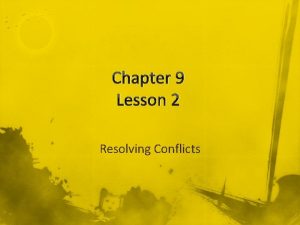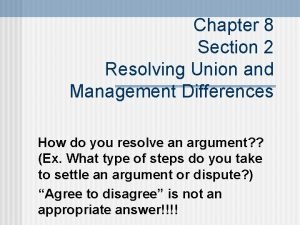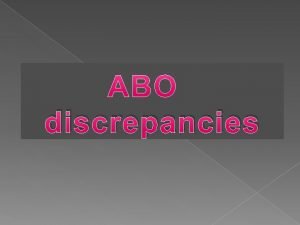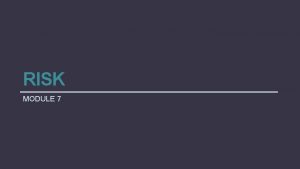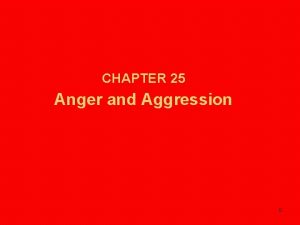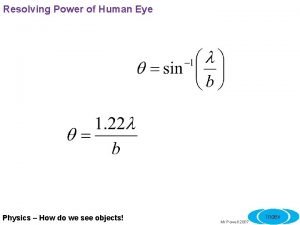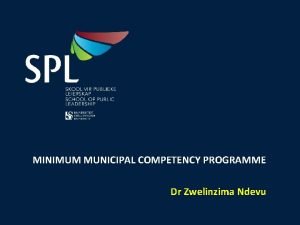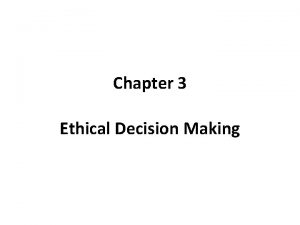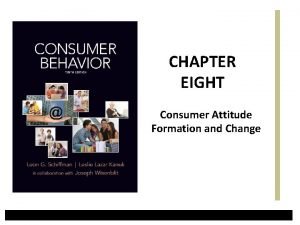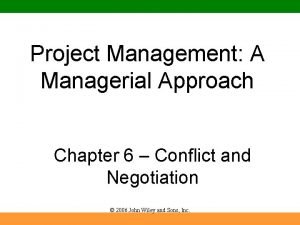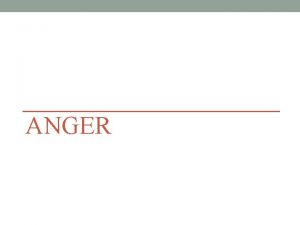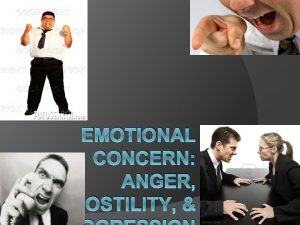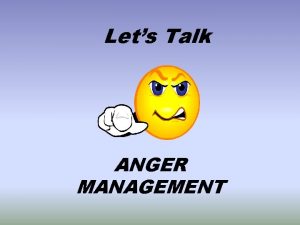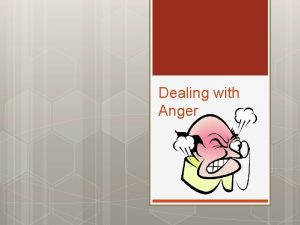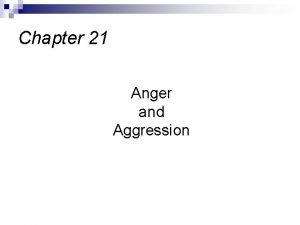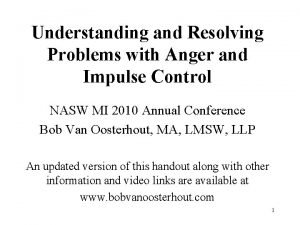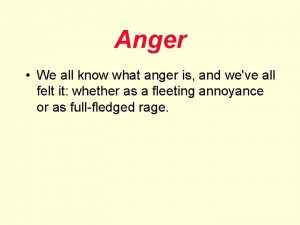Module 5 Chapter 5 Managing Anger and Resolving

















- Slides: 17

Module 5/ Chapter 5 Managing Anger and Resolving Conflicts “Balancing your anger balances your life”

CHAPTER 5 OUTLINE n What is Anger? n Managing the Anger Within n Anger and Stress: The Connection n Dealing with an Angry Person n Transactional analysis n The time-out procedure n The “upset” philosophy n Active listening n Summary Points

Basic Terms n Anger: A normal emotion one normally encounters when presented with an obstacle or difficulty in accomplishing a desired goal in a desired way in a desired time frame. n Conflict: A situation involving anger between two or more people.

What Anger is… n n n n An emotional response A Warning signal A way to new learning A normal feeling Healthy within limits A protective mechanism Useful within limits

What Anger is Not … n n n n Not a problem solving tool Not an outlet for revenge Not projection Not being violent Not a way of control Not healthy if it exceeds limits Not useful if inappropriate

Managing The Anger Within: Unhealthy Ways Denying: I don’t have this problem Hiding: Not showing overt feelings Repressing: Using it a later time Suppressing: It is not a norm to be angry Free expression: Venting out Creative aggression (constructive anger): Expression in a controlled and dignified manner with the hope that others will listen n Unconditional Forgiveness: Often impractical and may result in harm in other forms n n n

Managing The Anger Within: Best Healthy Way n According to Rational Emotive Therapy the BEST Healthy Way is by: n Showing annoyance and irritation

Managing Anger: The Eastern Way n Introspection: A self-analysis process exploring the reasons and motivations behind one’s own behaviors. n Apologizing & Determining to Rectify our contribution n Understanding that not everything can be changed, altered or fixed n Letting Go

Dealing with an Angry Person: Transactional Analysis n An interpersonal analysis technique based on assumption of three ego states, parent, adult, and child within each individual. n Best way to deal with an angry person is to give a “caring parent” response followed by a “rational adult” response.

Dealing with an Angry Person: Time Out … 1 Three steps: STOP, THINK, ACT A. STOP (NEED FOR TIME OUT) n Indicate that you are feeling angry n Discuss the need for time out and/or time away from the situation n Leave the situation

Dealing with an Angry Person: Time Out … 2 n B. THINK (TAKE TIME TO ASSESS THE SITUATION) n Work at calming down the body n CALMING REMINDERS: Avoid taking anger personally n Maintain a sense of self worth n Maintain perspective n Avoid feeding fears n Decide to be in control n Avoid being judgmental n Maintain a problem solving attitude n Become receptive to views of others n

Dealing with an Angry Person: Time Out … 3 n C. ACT (COMING BACK AFTER TAKING TIME OUT) n Be willing to admit to self and others that you might have been a contributing factor n Agree to work together to continue discussing problems n n Empathic listening: “What you were saying was. . . ” Fogging: “Let me think about that. . . ” Admitting mistake: “You were right, it was wrong for me to. . . ” Negative inquiry: “Are there other things that I do to hurt you. . . ”

Dealing with an Angry Person: “Upset” Philosophy TRIGGERING SITUATION SOLUTION DEPENDENCY Person cannot find alternatives EXPLORE CHOICES AUTHORITY: Position, expertise or wealth DISCUSS or IGNORE UNCLEAR LIMITS ASKING SECIFIC DIRECTIONS COMPLEXITY BREAKING DOWN TASK IN SMALLER UNITS PRIOR UNRESOLVED CONFLICT FORGIVE & FORGET COMMUNICATION PROBLEMS LISTEN & DISCUSS CONFLICT OF INTEREST DISCUSS or IGNORE

Dealing with an Angry Person: Active Listening n n n n Diagnostic tool Disarming device Helps in clarification Helps in rationalizing Develops clear thinking Improves communication Preserves dignity

Conflict Resolution Modes n Competition: Quick decisions n Collaboration: Integrating solutions n Avoidance: Trivial issues n Accommodation: Show being reasonable when you are wrong n Compromise: When goals are important but not worth the effort to cause any disruption

Thoughts for Reflection n Read and reflect with a partner: n 5. 1 What anger is n 5. 2 What anger is not n 5. 3 Points to Ponder n 5. 4 Resolving conflicts by managing anger n 5. 5 Five conflict handling orientations n 5. 6 Calming reminders n 5. 7 The value of “I” messages

Skill Building Activities n Complete Worksheet 5. 1: Self-Assessment of Anger n Complete Worksheet 5. 2: Managing Your Anger n Complete Worksheet 5. 3: Learning Active Listening n Complete Worksheet 5. 4: Transforming Anger into Behavior Change Goals
 Chapter 9 resolving conflicts and preventing violence
Chapter 9 resolving conflicts and preventing violence Chapter 9 resolving conflicts and preventing violence
Chapter 9 resolving conflicts and preventing violence Chapter 9 lesson 2 resolving conflicts
Chapter 9 lesson 2 resolving conflicts Chapter 9 lesson 2 resolving conflicts answer key
Chapter 9 lesson 2 resolving conflicts answer key Many new drivers first fender bender is a backing collision
Many new drivers first fender bender is a backing collision Module 4 topic 1 assessing and managing risk
Module 4 topic 1 assessing and managing risk Dispersive power of a grating is defined as
Dispersive power of a grating is defined as Recognizing and resolving abo discrepancies
Recognizing and resolving abo discrepancies Module 7 managing risk answer key
Module 7 managing risk answer key Chapter 27 anger aggression and violence
Chapter 27 anger aggression and violence Assault cycle stages
Assault cycle stages Coherent and incoherent sources of light
Coherent and incoherent sources of light Telescope equations
Telescope equations Resolving power of human eye in mm
Resolving power of human eye in mm 5 steps in resolving ethical dilemmas
5 steps in resolving ethical dilemmas Ethical dilemma situation
Ethical dilemma situation Motivational function
Motivational function The favored technique for resolving conflict is *
The favored technique for resolving conflict is *


